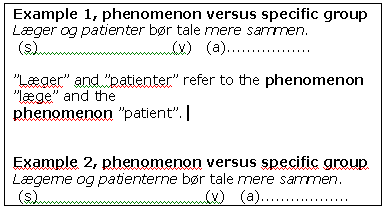Noun forms: Indefinite to definite
In English, it is standard practice to write nouns in the indefinite form when they refer to a specific group. You cannot transfer this to Danish. In Danish, the indefinite form indicates that you are dealing with groups, entities or concepts as a phenomenon ("hunde skal føres i snor" (dogs should be kept on a leash) = the concept "dog"), while the definite from refers to a specific group ("hundene skal føres i snor" (the dogs should be kept on a leash) = specific dogs, such as my aunt's dogs) (examples 1-2). In Danish, the definite form also indicates that you are referring to all the persons or phenomena of a group and not just some of them (example 3).
When an English noun in indefinite form refers to a specific group, you should choose one of the following solutions in the Danish translation in most cases:
- Change the noun to definite form by putting the definite article at the end of the noun
(patienter -> Patienterne)
- Put a demonstrative pronoun in front of the noun
(ældre patienter -> de ældre patienter)
- Put a demonstrative pronoun in front of the noun and an inserted sentence after the noun
(ældre patienter behandlet med -> de ældre patienter, der blev behandlet med).
Here, you are dealing with a specific group of doctors and patients (i.e. the ones in a specific hospital).
Example 3, "some of" versus "all of" .
Patients treated with Flenoflax had serious adverse reactions compared to patients in the placebo arm in clinical trials.
The sentence in English refers to all the patients in a group that were treated with Flenoflax. This has not been translated correctly into Danish because of the indefinite form. This is because the Danish indefinite form only refers to the concept (i.e. the phenomenon you are dealing with: patients as opposed to lamps or pens). Therefore, the Danish reader cannot be certain if "patienter" means that some of or all of the patients treated with Flenoflax had serious adverse reactions. To communicate the right message, the sentence should be translated as follows:
Precise translation:
I kliniske forsøg fik de patienter, der modtog behandling med Flenoflax alvorlige bivirkninger, mens der ikke sås bivirkninger hos patienterne i placeboarmen.


